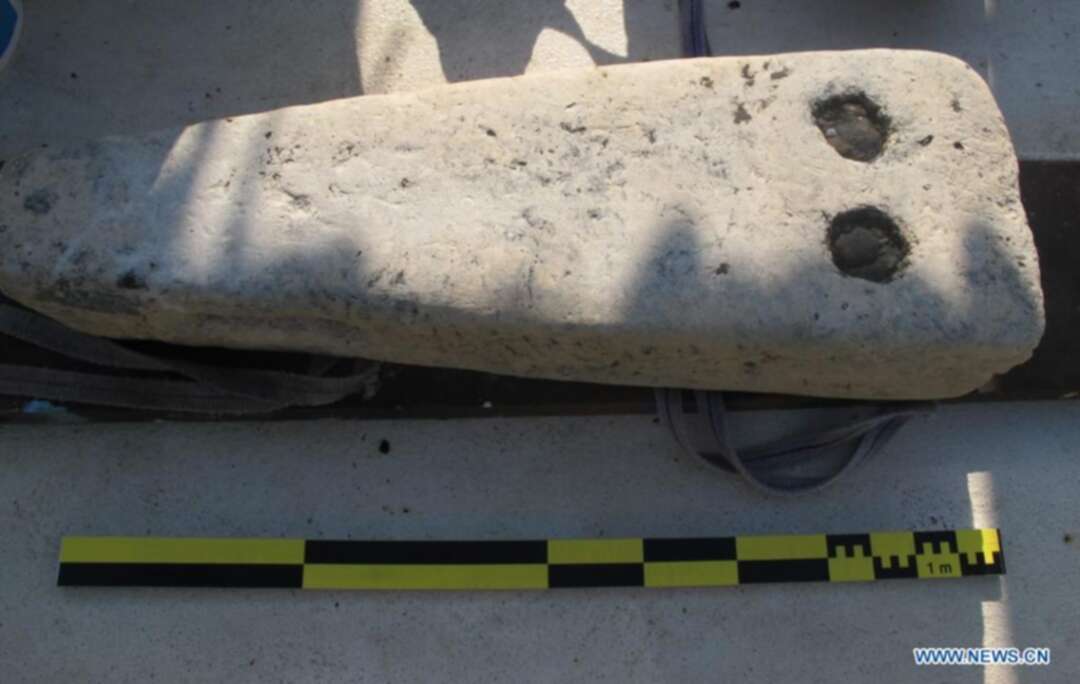-
Egyptian-French underwater mission in Alexandria uncovers remains of military vessel and funerary complex

The Xinhuanet reported according to a statement by Egypt's Ministry of Tourism and Antiquities on Monday, the Egyptian-French underwater mission in the coastal city of Alexandria in Egypt has uncovered remains of a military vessel and a funerary complex.
Mostafa Waziri, secretary-general of the Supreme Council of Antiquities (SCA) said: "The Ptolemaic-era military ship was discovered in the submerged city of Thonis-Heracleion, which sunk as the famed Amun temple collapsed during a cataclysmic earthquake happened in the second century B.C.".
"When the earthquake happened, the ship was supposed to land in the canal along the south face of the temple and was covered by huge blocs of the falling temple," Waziri said, adding the temple blocks have kept the ship remains nailed down to the bottom of the deep canal.
Ayman Ashmawy, head of Egyptian Antiquities Sector at the Ministry of Tourism and Antiquities said: "The mission used a cutting-edge prototype sub-bottom profiler electronic equipment to detect the ship nearly five meters under hard clay mingled with vestiges of the temple."
The discovery proved significant in that the finds of fast ships of that era remain extremely rare, especially when the Hellenistic ships of this type were completely unknown before this discovery, said Ashmawy.
Ehab Fahmy, head of the Central Department of Underwater Antiquities said: "The ship also carried features of ancient Egyptian type of construction."
The longboat was flat-bottomed and had a flat keel, which constitutes quite advantageous features for the navigation on the Nile and within the Delta, according to Fahmy.
Some typical ancient Egyptian shipbuilding features, together with the evidence for wood reuse, indicate that the ship was built in Egypt, he added.
In another part of the Heracleion city, remains of a large Greek funerary area that dated back to the 4th century B.C. were discovered alongside the north-east entrance canal, Fahmy said.
"The discovery proved the presence of the Greek merchants in Heracleion. They controlled the entrance to Egypt at the mouth of the Canopic branch of the Nile," he said, adding that these merchants were allowed to live in Heracleion during the late Pharaonic dynasties and built their own sanctuaries close to the Amun temple.
According to the ministry statement, Heracleion used to be the largest port of Egypt on the Mediterranean Sea for many centuries before the foundation of Alexandria in 331 B.C. by Alexander the Great.
Source: xinhuanet
Image source: Ministry of Tourism and Antiquities-xinhuanet
You May Also Like
Popular Posts
Caricature
BENEFIT Sponsors BuildHer...
- April 23, 2025
BENEFIT, the Kingdom’s innovator and leading company in Fintech and electronic financial transactions service, has sponsored the BuildHer CityHack 2025 Hackathon, a two-day event spearheaded by the College of Engineering and Technology at the Royal University for Women (RUW).
Aimed at secondary school students, the event brought together a distinguished group of academic professionals and technology experts to mentor and inspire young participants.
More than 100 high school students from across the Kingdom of Bahrain took part in the hackathon, which featured an intensive programme of training workshops and hands-on sessions. These activities were tailored to enhance participants’ critical thinking, collaborative problem-solving, and team-building capabilities, while also encouraging the development of practical and sustainable solutions to contemporary challenges using modern technological tools.
BENEFIT’s Chief Executive Mr. Abdulwahed AlJanahi, commented: “Our support for this educational hackathon reflects our long-term strategic vision to nurture the talents of emerging national youth and empower the next generation of accomplished female leaders in technology. By fostering creativity and innovation, we aim to contribute meaningfully to Bahrain’s comprehensive development goals and align with the aspirations outlined in the Kingdom’s Vision 2030—an ambition in which BENEFIT plays a central role.”
Professor Riyadh Yousif Hamzah, President of the Royal University for Women, commented: “This initiative reflects our commitment to advancing women in STEM fields. We're cultivating a generation of creative, solution-driven female leaders who will drive national development. Our partnership with BENEFIT exemplifies the powerful synergy between academia and private sector in supporting educational innovation.”
Hanan Abdulla Hasan, Senior Manager, PR & Communication at BENEFIT, said: “We are honoured to collaborate with RUW in supporting this remarkable technology-focused event. It highlights our commitment to social responsibility, and our ongoing efforts to enhance the digital and innovation capabilities of young Bahraini women and foster their ability to harness technological tools in the service of a smarter, more sustainable future.”
For his part, Dr. Humam ElAgha, Acting Dean of the College of Engineering and Technology at the University, said: “BuildHer CityHack 2025 embodies our hands-on approach to education. By tackling real-world problems through creative thinking and sustainable solutions, we're preparing women to thrive in the knowledge economy – a cornerstone of the University's vision.”
opinion
Report
ads
Newsletter
Subscribe to our mailing list to get the new updates!






















